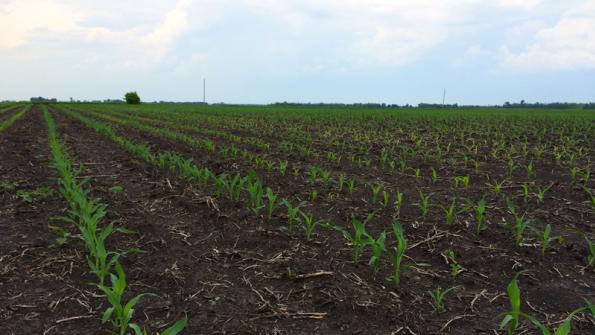
What started out as an early warm spring has stalled in many areas at the moment. Now, faced with cool, wet conditions after planting (or before soybean planting), many farmers are questioning the impact on corn seed germination and emergence. Corn+Soybean Digest sought answers from agronomists .
1. Relax. Corn can take weeks for seedlings to emerge.
The one thing we do know at this point is that we may not know how much the corn fields have been impacted because it can take up to three or more weeks to emerge. This is because of the relationship between GDD accumulation and emergence.
Seedling emergence is dependent on soil temperature and air temperature, according to Ohio State University. Also, keep in mind that emergence estimates based on Growing Degree Days are approximate – influenced by various factors including residue cover, tillage, planting depth, hybrid differences, and soil organic matter and moisture/oxygen content.
2. Temperatures at or below 50 °F can impact final plant stands, depending on the duration of low temperatures following planting. And as you know, stand loss is usually greater on heavier and poorly drained soils.
3. Once fields dry out, a pre-emergence herbicide with residual control is recommended to provide some early weed control and allow for a wider window to apply post emergence herbicides.
4. Consider increasing corn seeding rates when planting resumes, especially in a corn-on-corn or high-residue situation.
5. Soybeans don’t get a break when it comes to the wet, cool conditions either. The wet soils after soybean planting can cause uneven emergence and stand reductions depending on the plant stage and other environmental factors including temperature and duration of saturated conditions. Additionally, increased disease incidence may further reduce plant stand.
6. According to the University of Nebraska-Lincoln, producers may want to consider a fungicide seed treatment due to the saturated soil with cold temperatures.
7. After 48 hours of flood conditions, soybean germination was reduced 33-70% depending on when imbibition (seed taking up water) began relative to the flooding conditions. This means if soybean seeds were further along in the germination process when flooding occurred, the seeds will be more susceptible to flooding stress.
8. If soybeans were planted shortly before heavy rainfall, it is important to evaluate soybean stands in the next couple of weeks. To quickly estimate stand, count the number of plants in 69’8” of row for 7.5-inch row spacing, 34’10” for 15-inch row spacing, or 17’5” of row for 30-inch row spacing. These counts represent 1/1000th of an acre (i.e., 120 plants in 7.5-inch row spacing = 120,000 plants/acre).
9. Keep in mind, the effect of soybean plant population on yield is very small over the normal range of seeding rates. At this time of the year, final populations of 100,000 to 120,000 plants/acre are generally adequate for maximum economic return.
About the Author(s)
You May Also Like




